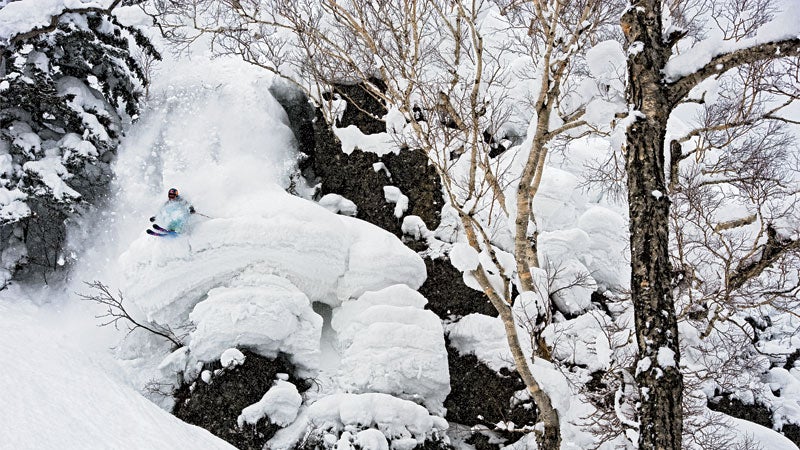After three sunny days, Niseko is finally getting back to normal. It's snowing.
I'm with a dozen members of a snowboard club from Tokyo, and together we zip down a short run covered in fairy dust, then ride the lift back to the top of the mountain, only to discover that, in the ten minutes we spent on the chair, a fresh sifting of white has completely filled in our tracks.
“The run reset,” says Mucchan, a member of the club.
We traverse into a glade of snow-pasted birch—what some here call juhyo (“ice trees”) or snow monsters, for the way the clumps of powder that stick to their limbs can leap down and startle you when disturbed—and then shimmy onto a second pitch where more dandruff of the gods awaits. There's no rush. Despite the abundance of great snow, Mucchan and Kenchan and Tsunota and the others and I wait for each other at the bottom of every pitch. “Psycho!” someone says. High fives are traded. A plan for the next run is agreed on. Our communication is slowed by their choppy English and my desire to speak using a second-hand Japanese phrase book, but even so, I have never experienced a powder day anywhere close to this peaceful.
I shouldn't be surprised. Niseko lies somewhere between a full-blown destination resort and a laid-back locals' hill. Called , it's technically four separate resorts, whose braids of pistes all radiate from the same volcano on the northern island of Hokkaido, a short 1.5-hour flight from Tokyo. Combined, the resorts are and offer a respectable 3,000-foot drop. But it's the consistent nature of the storms here that sets Niseko apart. Before the recent three-day drought, for example, snow fell constantly, an average of seven inches a day, for three weeks. And that's only slightly better than a typical start to the season.
Mucchan doesn't share my astonishment, though.
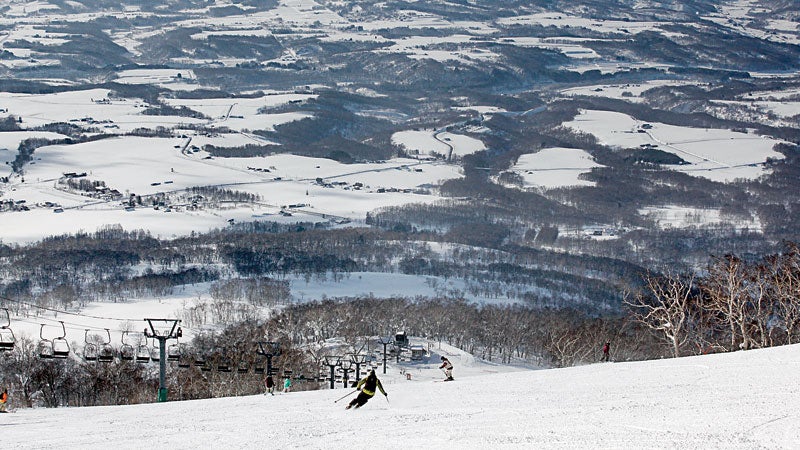
“Have you ever skied Whistler?” she asks.
I tell her that I have, and I acknowledge that, trumps the mellower slopes of Niseko, but I also try to point out the obvious, how the flakes are now coming down so thick that it's obscuring the horizon, how the air is so thoroughly snow-fogged that the lift operators have turned on halogen floodlights—the kind most resorts use only for night skiing. No luck. Her mind wanders, the blizzard too banal to merit discussion.
“Have you skied in Aspen?” she asks.
After a couple of group photos, Mucchan and the others call it a day and head in to the lodge, where most of my fellow skiers are already posted up around yards of beer like so many oil derricks.
So I ski alone, poofing through fluff and leaping off pillow drops and never sharing a chair, all while bits of white drift toward earth and swirl skyward, dye-in-water style, on an almost imperceptible breeze. “Aoooooooo!” I howl, bringing my skis to a hissing stop after another half-dozen untracked runs. I can't see or hear another human being.
I'm alone in the whiteout, accompanied by little more than the tinny sound of Motown being broadcast from one of the lift-mounted speakers common at Japanese ski resorts. (“Upside down, boy you turn me,” Diana Ross sings—or maybe it's a Japanese cover band.) I pause to count how much time elapses before a fellow powder hound appears. Ten chilly minutes pass, and I have my answer.
It's a little after 2 P.M. on a Saturday afternoon, at the height of ski season, in a storm that will deposit some two and a half feet of frozen H's and O's in 24 hours, and my lone companion, the only other skier sharing my stoke on this part of the mountain, is a hunched old Japanese man, moving slowly and concentrating on every pole plant.
I turn downhill and ski after him. In Niseko, everyone's a friend on a powder day.
[quote]Visit Niseko for ten days in January and you will ski nearly five feet of fresh snow—more than most resorts receive in a month.[/quote]
UNLIKE UTAHANS, whose license plates read “Greatest Snow on Earth,” or Coloradans, who in Steamboat have trademarked the term champagne powder, the Japanese in Niseko do not flaunt, or often even appreciate, what they have. But even the most exotic powder stashes eventually get sniffed out, and over the past ten years the resort has quietly become the stuff of legend among the skiing cognoscenti.
Though only about 5,000 Americans visit Niseko each year, I had read their rhapsodic accounts, had seen their otherworldly pictures and hypnotic movie clips. I dismissed all the face shots as the result of patience or good fortune or smart editing. I didn't truly understand how special Niseko is until I called up Tony Crocker.
Crocker is a 60-year-old insurance actuary from Glendale, California, and the numbers savant behind , the most thorough collection of normalized snowfall records and precipitation trends for North American ski resorts. “I never saw snow fall out of the sky until I was an undergrad at Princeton,” Crocker told me. He became obsessed with it during the record-setting blizzards of 1978 and has been chasing powder ever since.
As a passionate skier long trapped in New York City, I'd hoped Crocker could help me figure out the statistically best week to visit one of North America's more powder-blessed resorts. While Crocker had lots of numerical insights—Jackson Hole peaks in January, Utah in February, most of Colorado in March—he couldn't pin down a specific window.
If there's anything that his decades of regression analysis and standard deviations have taught him, it's that predicting the weather is really hard. “The bottom line is, if you're serious about powder, move to within a day's drive of one of those resorts,” he said. Then he added the magic qualifier: “Unless we're talking about Niseko.”
Blanketed by 580 inches a year, Niseko averages twice as much snow as most resorts in North America. Only Mount Baker, with 652 inches, sees more. But while this fact is fairly well-known, virtually every ski movie, trip report, and barroom tale misses one key detail, Crocker explained. Unlike most ski resorts, Niseko gets the overwhelming majority of its tremendous snowfall in December and January. On average, it receives 45 percent more snow in January than Mount Baker. And the water content of that snow is about the same as at Alta, which typically sees the driest powder in the U.S.
Scientists call it ocean-effect snow. In early December, supercooled air starts blowing in from the frigid plains of Siberia, sucking up moisture from the Sea of Japan and dropping the results on Hokkaido's lonely volcanoes. The coldness of the January air, combined with Niseko's prime, snow-catching location on the western side of the island, creates what is essentially a monthlong, uninterrupted storm. Nearly 15 feet of fukai yuki saiko land on the humble mountain in January alone, an average of almost six inches a day.
Visit Niseko for ten days in January and you will ski nearly five feet of fresh snow—more than most resorts receive in a month. Venture into the glades or go cat skiing and you'll almost certainly experience movie-quality powder. When professional freeskiers J.P. Auclair and Chris Benchetler skied there in January of 2009, for , the cloudlike snow wasn't “epic,” as they boasted in the film, it was statistically normal. And when Crocker quit , where he had worked his entire professional life, he didn't go heli-skiing in Alaska or move to Salt Lake City. “When I retired,” he said, “the first trip I took was to Niseko in January.”
Sold. A week later, I booked a ticket.
THE JAPANESE HAVE a deep and abiding love for skiing, even if most of them don't technically shred. The country's two most mountainous islands, from the frigid northern tip of Hokkaido to the subtropical southern tip of Honshu, are dotted with some 600 resorts. (The United States, by comparison, has about 425.) Japan has hosted the twice: in Sapporo, 60 miles east of Niseko, in 1972, and in Nagano, 130 miles northwest of Tokyo, on Honshu, in 1998.
After World War II, during Japan's economic heyday, families cut down trees and strung up single lifts, mom-and-pop-style, just about anywhere they could, including Niseko. But the sport didn't take off until the big-money eighties, when hotels were built and schools started busing entire classes to the hills for instruction. Then, in 1990, the Nikkei crashed and development stalled. Enough ski resorts were simply abandoned that photographers dedicate entire blogs to Japanese-ski-resort-decay porn. In Hokkaido, many surviving resorts now appear frozen in time.
Niseko is the exception, thanks largely to its growing popularity among Australians, who, after 9/11, realized that the region receives more snow than Whistler and is much closer to home. The resort is made up of three base areas: Annupuri, Niseko Village, and Grand Hirafu. (Hanazono is technically a fourth, but it has little more than a day lodge.) Annupuri is the smallest and most relaxed, with a seventies feel and a cluster of wooden chalets, funky coffee shops, and restaurants. Niseko Village is dominated by an enormous Hilton hotel shaped like a giant soda can, which towers over the base area, and offers unusual winter-sport activities like snow rafting, in which a snowmobile pulls a rubber raft full of people around a groomed field. Hirafu sits at the historic heart of the resort and is now a compact, architectural hodgepodge village teeming with hordes of young Aussie holidayers.
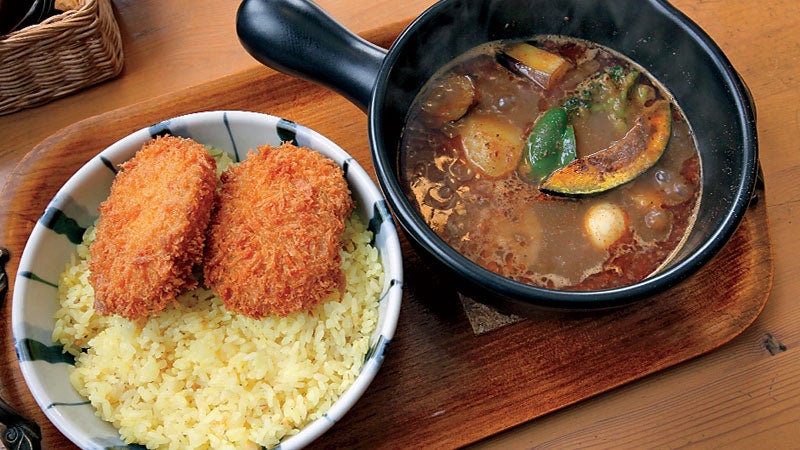
Despite the development, Niseko remains pastoral, surrounded by rectangular farms and patchwork forests, and the vibe is down-home. Pure water bubbles up from seemingly everywhere in the form of onsens, or geothermal hot springs, and community-maintained mineral springs, where restaurants fill their water jugs nightly. On the mountain, scannable passes are about as modern as things get. Many lifts are doubles or even singles. A winter farmers' market does a steady business selling organic turnips, pickles, rice, and sake. ATMs are scarce, and when I finally find one, it doesn't recognize my card.
The other thing that makes Niseko unique is that it's one of a handful of resorts in safety-conscious Japan with an open-boundary policy. Nine gates along the periphery give way to hundreds of acres of uncontrolled terrain. Often referred to as “local rules,” Niseko's unusually lax policies have spawned a half-dozen backcountry guiding services, and the area is home to three cat-skiing operations.
When I arrived in Niseko on January 21, snow was suffocating the town. Driving around, I saw an excavator teetering on a mound of snow taller than a mini-mart, while up the street a front-end loader dumped great avalanches of the stuff into a line of idling 18-wheelers. Snowblowers tunneled out side-walks, and hotel maintenance workers scurried from room to room, heaving shimmering flurries off the balconies. Keeping Niseko accessible until the bamboo pokes through in March costs the local government over $1 million a month. They don't pray for snow, they look for places to put it.
On my first full day, under atypical bluebird skies, I signed up for a day of backcountry skiing on another nearby volcano, Yotei, with the Niseko Powder Company, a laid-back bunch of beer-drinking Japanese dudes who wouldn't be out of place in Crested Butte.
“You are very lucky,” said Mako, a tall, broad-shouldered guide who had spent much of his early twenties snowboarding in Alaska. “We haven't seen sun in three weeks.”
My companions were three young couples, professionals from Tokyo, and we dropped one by one down Yotei's wide west face, which was covered in a couple of feet of light, untracked snow. After especially great pitches, everyone would clap or shout “Sugoi!“—making it tough to remember that these were urologists, video-game producers, and 2-D illustrators. But, generally, the couples remained quiet, keeping a lookout for tanukis—dog-like animals that have faces similar to a raccoon's and, according to folklore, shape-shifting powers. The riders all shared a recognizable style. Whenever possible, they'd make enormous swooping turns, their arms outstretched like wings, and in gullies they buried the nose of their boards and kicked out the tail, sending up sparkling waves of spray.
I finally asked the illustrator in the group what was up.
“Surf style!” was his enthusiastic reply.
Surf style, I would later learn, was almost a Zen kind of riding. According to Muchan, it was “about blending with the energy of the mountain,” and it was the predominant way of snowboarding in Niseko, thanks to a local former pro named Taro Tamai.
In 1998, unhappy with the punky direction snowboarding was taking, Tamai decided to launch his own line of handmade boards, with distinctive split tails, minimal graphics, and bindings mounted far back of center, so riders could weight their front foot, even in deep powder. Gentemstick, as he called his hobby business, took off, and the surf style his boards inspired became the soulful center of Niseko riding. Every decent rider in Niseko pilots a Gentemstick, including each of the eight snowboarders with me on Yotei.
You pretty much have to visit Tamai's showroom if you want your own Gentemstick, though that's starting to change. A few small stores in Europe sell them now, and the Levitation Project, a boutique snowboard shop at the base of Utah's Big Cottonwood Canyon, will have a couple in stock this season.
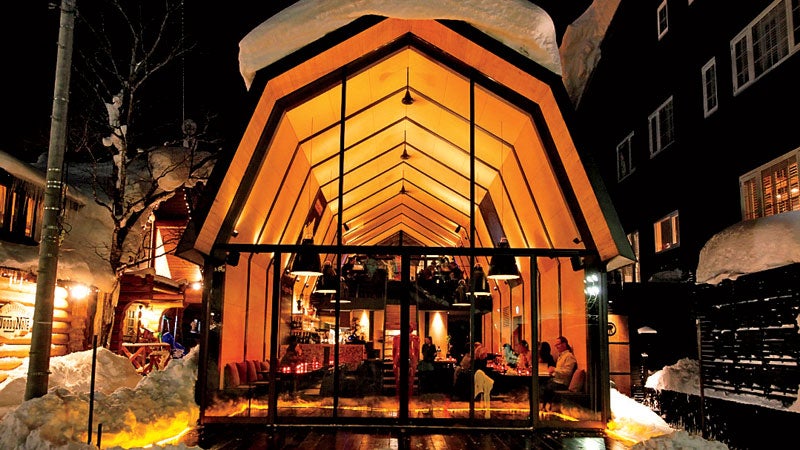
ON MY SECOND DAY, the sun was once again shining. I was starting to worry that Crocker had cooked his books and I might have to suffer the indignity of consulting a weather forecast. But instead I trusted fate and skied a few laps in the resort, threading my way through swarms of students in matching rental uniforms and groups of Chinese speakers who fell over often and seemed to lie there for an abnormally long period of time. I paused for noodles at a midmountain restaurant and accepted an invitation from an older Japanese couple to carve perfect figure-eight turns.
Annoyed by all the vitamin D and the glorious blue skies, I called it a day early. I had accommodations that evening at a health spa called Kanronomori, or Sweet Dew of the Forest, located at the edge of Annupuri. The place has four onsens, and when I entered the vast lobby, sonorous music surrounded me. So did thick clouds of cigarette smoke. The spa had fully embraced the Japanese love of chain-smoking and ashtrays, and smokers in robes abounded. Getting into the mood, I plopped down in my suite, lit up, and let the programmable massage chair squeeze my thighs as I balanced one of the half-dozen ashtrays in the room on the vibrating armrests.
The next few nights I was booked at a hotel in Hirafu, which felt like another dimension. There were nouveau-hippie-artist whiskey bars in the center of town, multimillion-dollar homes on the outskirts, and Aussies everywhere in between. They ordered scones at the , tandoori chicken at the Indian food truck, and pints of Guinness at Paddy McGinty's. I just about dropped my fork one night when a diminutive Japanese waitress referred to me as “mate.” “So many people with golden hair!” said a Hong Kong travel agent on her first visit to Hirafu, and I had to agree.
The flakes started to fall late on the third night, which is when I met the Tokyo snowboard club at a cozy and boisterous izakaya restaurant at the bottom of town. They kindly agreed to show me around the next day and even waited 30 minutes after the appointed time, until we finally found each other in the crowd of Asians and golden hairs.
After our excellent day of dodging snow monsters, my legs needed rest, but I had to celebrate. So I headed out for a drink at a log-cabin bar a couple of blocks from my hotel. Unbeknownst to me it was Australia Day, the sunburnt continent's version of the Fourth of July, and the bar was packed with young men chugging beers out of kegger-style cups. Many of them had wrapped themselves in the Australian flag, while others were draped around the pool table wearing fuzzy, undersized kangaroo costumes.
“So what's Australia Day all about?” I asked the first guy I meet.
“It's about gettin' hell drunk and fightin', ” the kid said.
Ten minutes later, he made good on the statement. I stepped outside to find him shouting taunts down the otherwise peaceful street, until his equally drunk foe decided he'd had enough, removed his shirt, and proceeded to punch the kid in the back of the head.
“At least he didn't get glassed,” the bartender said as I related the story.
Glassing, he explained, is when a bogan, or Australian redneck, smashes a beer bottle into another bogan's head or face. According to the bartender, glassing has become a full-blown Australia Day tradition in Niseko.
“Why do you think we're serving in plastic cups?” he asked.
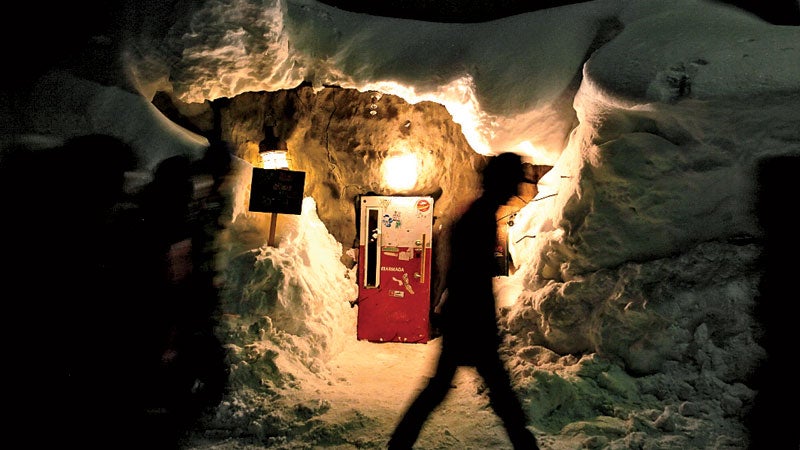
FOR THE NEXT four days, I tour , ski powder at night under Hirafu's impressive constellation of lights, and hunt down the virtually untouched snow that remains just outside the resort's gates. Though it snows only two afternoons, finding fresh powder is almost never a problem.
Even so, I've grown spoiled. When I'm forced to ski cut-up waist-deep powder, I get grouchy. Feeling entitled, I sign up for a day of cat skiing with Niseko ���ϳԹ��� Centre, a newly opened operation based out of an abandoned resort behind Niseko. The only other guest is a retired Canadian CEO on a round-the-world ski trip. For six hours, we leave trails of cold smoke down a long, shallow bowl and blast through wind lips and fly out exit drainages. It is one of the best powder days I've ever experienced.
This is especially remarkable when you consider that my week has, by Niseko standards, been arid. A mere two and a half feet of snow have fallen, a full foot below average. Even so, I'm convinced that Niseko is probably the best ski resort in the world, so long as you can look beyond the bogans glassing each other on 'Straya day. And don't gaze too far into the future.
Thanks in part to the 2008 Chinese blockbuster , a rom-com in which a beautiful stewardess shows a rich businessman the rugged beauty of Hokkaido, Chinese interest in the island has been piqued. Never mind that the Chinese and Japanese intensely dislike one another, a reported 80 percent of all condo buyers in Niseko two years ago were Chinese and Singaporean, and the list of swanky new accommodations catering to them is long, culminating, in five to ten years, with the opening of a $1.5 billion project that will feature 3,000 luxury condos, a Louis Vuitton store, and hot-air-balloon rides.
This mega-development will likely sour Niseko's chilled-out vibe, a fact that concerns some of the locals I skied with over the course of the week. But my concerns are more immediate, like the fact that somehow I managed to visit just two onsens, roughly five fewer than I should have. And I haven't soaked at the legendary Goshiki onsen, a lonely tub overflowing with hot spring water at the end of a backcountry run. Before I left for Japan, multiple pro skiers had insisted I visit.
So at two o'clock on my last day, despite the fact that another storm is blowing in, I'm determined to ski off the back side of the summit to Goshiki. I tromp into the clouds. In a whiteout at the top, I manage to find the ski patrol's emergency hut, push open the ice-encrusted door, and wait. I'm not sure exactly how to get to Goshiki, so I hope that I can Jedi-mind-trick any savvy locals who might appear. A half-hour later, skinny Namioka, a software programmer, and plump Tetsushi, his boss at a company that automates oil refineries, arrive.
I ask them how to reach Goshiki onsen and they carefully and clearly explain, in decent English, all the landmarks and turns.
“Do I have to make any turns?” I ask.
“Yes,” says Tetsushi, explaining again.
“So I go this way?” I ask, gesturing vaguely into the clouds.
As I hoped, Namioka and Tetsushi offer to ditch their plans to ski back to the resort and instead agree to accompany me to Goshiki.
The skiing is horrible. At the top, we make survival turns around a field studded with hip-high ice clumps, then descend a wind-corrugated ridgeline. We chatter and side-slip down a long off-camber face, then drop into a forest where the clouds dissipate and the snow softens and we savor a couple hundred feet of the good stuff.
We land right at the brown building of the onsen. It's as brilliant as described, a shallow limestone and larch-wood pool, half indoor, half out, with a thick cornice of snow hanging from the flat roof. Aside from the attendant in his little booth, we have the place to ourselves. We undress, wash, and slip into 114-degree water.
“We thought you were suicide,” Tetsushi says with a laugh, recalling my insistence on heading blindly into the backcountry during a full-on blizzard.
We place snowballs on our heads to keep cool, soak our tired legs, and chat about surf style and tanukis, whose scrota are, according to legend, bigger and floppier than a bloodhound's ears.
Afterward, we buy Kirin tall boys from a vending machine and relax in the onsen's tatami room, with brown woven mats on the floor, sitting cushions, and a low wooden table. ���ϳԹ���, the storm relents. But the respite is short-lived. The day after I leave, it will start snowing again, an average of six inches a day for a month. Ultimately, my week in Niseko will prove to be the resort's worst between December and mid-February. But who gives a damn about statistics?
Eric Hansen wrote about his parents' decision to join the peace corps in ���ϳԹ���'����October 2013 issue.


